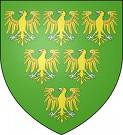I first heard of this film on Kathryn’s ‘Edward II’
blog. It was in production and that was
all I heard about it. So I was delighted
to see it for sale in Berkeley Castle shop.
I bought it of course! It tells
the story of Manuel de Fieschi’s quest to find out what happened at Berkeley
Castle in 1327. In an interview with the
screenwriter, A. G. Ford, on a second disc, the screenplay is first and
foremost written as a piece of drama, about a conversation between the supposed
Edward II and Manuel de Fieschi. It was the discovery of a copy of Manuel de
Fieschi’s letter that led to debate about the possible survival of Edward II,
and how he lived out his life as a hermit in Italy. So the film itself is not an exact account
of what de Fieschi claimed.
In this version, de Fieschi has attended the court of Edward
II and seen him and his lover Hugh Despencer at court. Later on, he claims to have been at Berkeley
and heard the screams of Edward II.
These scenes are in flashback, and we have a young de Fieschi as a priest
having heard the strange story of an English hermit who lives high on a remote mountain. We don’t really know why de Fieschi is
convinced the hermit is Edward – in fact, we just find out that he is desperate
to be taken to see this hermit, and the isolation and bleakness of the hermit’s
home dominates the first 20 minutes. When he reaches the remains of an old farm
inhabited by a woman who feeds the hermit, we learn about the life of
self-imposed hardship of the hermit. He
lives in a disused pig-sty, which he locks from the inside, and he is therefore
his own jailor. He comes out at certain
times to eat the bread and water left by the woman, with whom he has virtually
no contact. He has built his own altar and
appears daily to worship there. Fieschi
is deliberately portrayed as an arrogant young man with little calling to the
priesthood, and when the old man appears, he continually goads him for
deserting his duty as king. He cannot
understand how someone who has lived as a king can now live like this. The hermit goes about his business, washing,
eating etc, whilst Fieschi rants about the life Edward led with Piers Gaveston
(yes, he gets a mention!) and Hugh Despencer, reminding Edward of the awful
death suffered by Despencer. He talks
about life at the court and kingly duty.
Eventually, the hermit, who has not admitted to being Edward II, decides
to talk to the young priest and explains his reasoning. He speculates what this Edward might
say. Basically, the old man longs for
death, but will not take his life, and regrets nothing, except the death of the
old porter – the first admission by the hermit that he is Edward II. We are not able to witness their full
conversation, but de Fieschi comes away much moved by the hermit’s story. I have to admit, I found the film deeply
moving as well – to think that Edward now lived this poor, remote life with
nothing to look forward to but death.
There was no contact with anyone, and his life must have been dominated
by the events of his reign. It is of
course only an interpretation, but one that shows great sympathy for the
supposed Edward, and whilst I do not believe the ‘red hot poker story’ and
strongly believe Edward survived, it made me question the misery of the
survival he may have endured. Well worth
watching.













